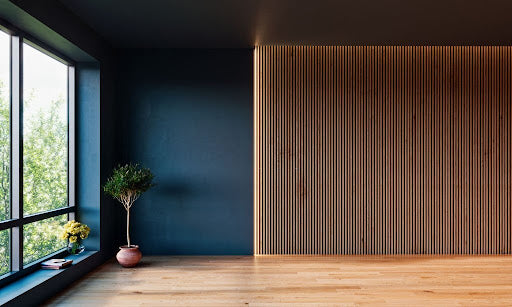
How Do Acoustic Panels Really Work? [2025]
2025-09-05 23:55
How Do Acoustic Panels Really Work? [2025]
Are you tired of echoes and distracting noise in your home studio or office? Unwanted sound, or "noise pollution," can significantly impact concentration, productivity, creativity, and even sleep. Fortunately, you can combat this issue effectively with acoustic panels, strategic furniture placement, and smart textile choices.

You might be asking, "do acoustic panels work," and are they truly worth investing in for your space? This guide will cover everything you need to know about what acoustic panels are, how do sound panels work, their different types, benefits, and installation tips, along with alternative echo reduction methods.
What are Acoustic Panels?
Acoustic panels are specialized products designed to minimize sound reverberation (echo) in interior spaces. They are typically crafted from porous materials like fabric, felt, foam, wood, or fiberglass, which are engineered to absorb sound waves rather than reflect them.
Beyond their functional benefits, acoustic panels are also available in a wide array of shapes, sizes, and designs, allowing them to enhance your space aesthetically. While standard panels often come in rectangular and square shapes for ease of installation, custom options are common, especially for larger commercial projects.
Many acoustic wall panels also offer thermal properties, providing additional insulation to help maintain consistent indoor temperatures. Installation is generally straightforward, making them suitable for diverse environments, from offices and home studios to restaurants and theaters.
How do Acoustic Panels Work?
The science behind acoustic paneling is quite effective. When sound waves encounter a hard surface (like drywall or concrete), they typically bounce back, creating echoes and extended reverberation times. Acoustic panels, however, operate by absorbing these sound waves instead of reflecting them. When a sound wave hits an acoustic wall panel, it penetrates the panel's porous material, becoming trapped and dissipated as heat. This process dramatically reduces the amount of sound reflected back into the room, significantly cutting down echoes and reverberations.
How to Choose the Right Acoustic Panel?
To assess an acoustic panel’s effectiveness, look at its Noise Reduction Coefficient (NRC). This rating (usually between 0.0 and 1.0, though sometimes higher) indicates how much sound the panel absorbs. A higher NRC means more sound absorption. For instance, a concrete wall has an NRC of about 0.05, reflecting 95% of sound. In contrast, a wood wall acoustic panel can boast an NRC of 0.85 or higher, absorbing around 85% of sound waves.
The Basics of Sound Absorption
Sound absorption occurs when sound waves hit a surface and are absorbed by the material rather than reflected. This process converts sound energy into heat, reducing noise. Sound-absorbing products typically feature porous materials and large surface areas to maximize absorption.
The Role of Porous Materials
Porous materials, with their low density and large surface area, are crucial for sound absorption. The small air pockets within these materials trap sound waves, dissipating their energy as heat. This is why materials like fiberglass, foam, and mineral wool are commonly used in acoustic panel construction.
The Function of Air Gaps
Air gaps significantly boost sound absorption, particularly for long-wavelength or low-frequency sounds that contribute most to echo. Spacing acoustic panels slightly off the wall (e.g., using MDF strips) creates an additional barrier. When sound passes through the panel, hits the wall, and reflects back through the panel again, it gets further diffused, potentially doubling the panel's NRC. This simple technique is highly effective for spaces requiring extra noise reduction, like restaurants.
Types of Acoustic Panels
Acoustic panels come in various forms, including fiberglass, foam, and wood. Each type offers distinct advantages.
Fiberglass Acoustic Panels
Fiberglass is a popular choice for acoustic walls due to its lightweight nature, ease of installation, and high sound absorption. It's a reliable and economical option that has been used in acoustic panels for a long time. These panels are typically fabric-wrapped, with fabric choices allowing for aesthetic customization. Fiberglass absorbs more sound than many other materials, making it excellent for situations where acoustics and budget are primary concerns.
Foam Acoustic Panels
Often seen in DIY home studios, foam panels are among the most common acoustic materials. They are affordable and don't require wrapping like fiberglass panels, making them a safe bet for beginners or those on a budget. While not always the most aesthetically pleasing, foam panels are effective at reducing excess noise. However, they can be difficult to clean as dust easily gets trapped, and they are relatively delicate.
Wood Slat Wall Panels
For those prioritizing sustainability and aesthetics, wood slat acoustic wall panels are an excellent choice. Made from wood veneers, MDF, and an acoustic felt backing, their fluted design enhances performance, absorbing up to 85% of sound. Installation is surprisingly simple: they can be screwed or nailed directly into walls or ceilings.
Benefits of Acoustic Panels
Beyond simply absorbing sound, these panels offer several compelling benefits for homes and offices.
Better Speech Intelligibility
In spaces where conversation is key (e.g., restaurants, living rooms), good acoustics are vital. Untreated rooms with hard surfaces cause sound to echo, making conversations difficult to understand and leading to "listener fatigue." Acoustic panels absorb these reflections, making speech clearer and fostering a more relaxed atmosphere.
Reduced Noise Pollution
Excessive noise can negatively impact health, leading to stress, sleep disturbances, and reduced cognitive performance. Installing acoustic walls significantly reduces noise pollution, creating a more productive, relaxing, and healthier environment for everyone.
Enhanced Productivity
In workspaces, poor acoustics can irritate employees and hinder concentration. By creating a quieter environment, acoustic panels help improve focus and overall productivity.
Improved Aesthetics
Modern acoustic panels, especially decorative ones, can significantly enhance a room's aesthetic appeal. Natural elements like wood provide a sophisticated look and can even hide minor wall imperfections.
Tips for Installing Acoustic Panels
Proper installation is key to maximizing effectiveness.
Choosing the Right Panel Placement
Careful consideration of panel placement is crucial. Research optimal positions, often opposite main sound sources. For example, placing panels behind a TV or couch in a living room can absorb sound from speakers. Corners are also effective, though they may require more frequent cleaning.
Proper Installation Techniques
Different panel materials require specific installation methods. Wood slat panels might use screws or adhesive, while foam panels typically use staples or construction glue. Always consult your supplier for recommended techniques.
Regular Cleaning and Maintenance
Maintaining your panels ensures their longevity and effectiveness. Smooth, pre-finished wood panels are easy to wipe clean. Wood slat panels can be vacuumed. Foam panels are more challenging to clean, and fiberglass panels require appropriate wrapping that can be vacuumed or lint-rolled.
Other Ways to Reduce Echo in Your Space
While acoustic panels are highly effective, other methods can also contribute to sound absorption, often working well in conjunction with panels.
Adding Soft Furnishings
Using soft fabrics for curtains and upholstery, and adding extra cushions, can significantly improve sound absorption. Decorative items like canvas art (over glass picture frames) also help.
Placing Furniture Strategically
Upholstered furniture, especially couches, absorbs more sound than wood. Bookshelves filled with books are remarkably effective at breaking up sound vibrations, contributing to quieter spaces like libraries.
Using Rugs and Carpets
Rugs and carpets are an easy way to cover hard floors and reduce noise from footfalls and echoes, as they absorb sound waves instead of reflecting them.
Using Fabric Blinds
Switching from metal or wood blinds to fabric blinds can significantly reduce echoes, as fabric absorbs sound waves. Noise-reduction curtains, though more expensive, offer even greater sound dampening.
Conclusion
Acoustic panels are an excellent solution for reducing environmental noise and reverberation. Available in various sizes, shapes, and designs, they not only improve sound quality but also serve decorative purposes, enhance productivity, and improve speech intelligibility. Investing in these noise-canceling panels is a win-win, transforming your office, home, or studio into a more serene and productive environment.
Ready to improve your space? Explore our range of high-quality acoustic solutions today!



